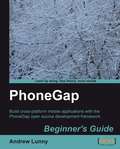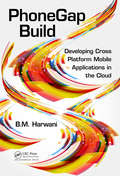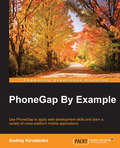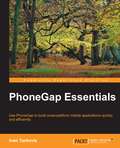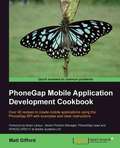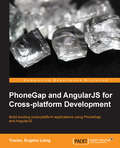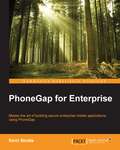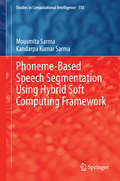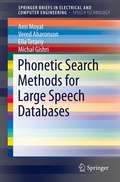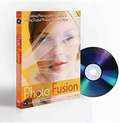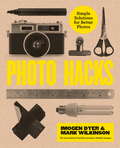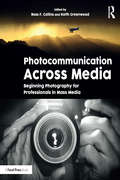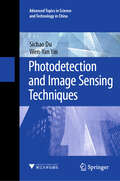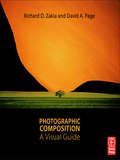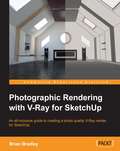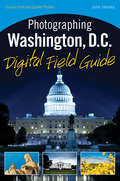- Table View
- List View
PhoneGap Beginner's Guide
by Andrew LunnyThis is a step-by-step guide written in an informal, friendly style, for beginners to learn building cross-platform mobile applications with PhoneGap. You will find plenty of fully explained code and ample screenshots in the book to ease and speed up your understanding. This book is for developers, ideally with web development experience, who are interested in developing for the emerging mobile market, but do not want to learn a new SDK for every phone on the shelf. Readers should be comfortable with JavaScript, HTML, and CSS, and interested in learning the new advances in those technologies that allow for rich, native-style experiences.
PhoneGap Build: Developing Cross Platform Mobile Applications in the Cloud
by Bintu HarwaniPhoneGap is a standards-based, open-source development framework that can be deployed to any mobile device without losing the features of the native app-allowing for access to device contacts, the local file system, camera, and media on multiple platforms without requiring users to write a single line of code. Ideal for intermediate to advanced users, this book offers the comprehensive coverage you need to harness the power of this dynamic tool. It provides complete coverage of the cloud computing platform and the theories behind cloud computing, using a series of engaging examples.
PhoneGap By Example
by Andrey KovalenkoUse PhoneGap to apply web development skills and learn variety of cross-platform mobile applications About This Book * Utilize the robust features of the mobile hybrid approach to develop, test, and publish mobile applications using the PhoneGap framework * Use your web skills for hybrid mobile application development and deliver to many mobile platforms without rewriting the code * Develop a set of ready-to-use mobile applications with this practical, comprehensive, step-by-step guide Who This Book Is For If you are a web developer with some experience in development of single page applications and want to enter the world of mobile applications, then this technology and book is ideal for you. Since PhoneGap maintains an incredibly easy-to-use plugin interface, no previous experience in native languages development (such as Objective-C or Java) is required. What You Will Learn * Set up plugins to access the camera and filesystem to capture media * Build a custom RESTful service and integrate it with a PhoneGap application * Integrate a HTML5 Canvas element to create mobile games * Build scalable applications using a modern mobile web framework * Interact with RESTful services from a mobile application * Build an audio/video chat facility using the PhoneGap and WebRTC technologies * Develop a PhoneGap plugin with native interfaces for iOS In Detail PhoneGap is a free and open source framework that allows you to create mobile apps using standardized web APIs for the platforms you care about. It is one of the first and fastest spreading tools to develop hybrid applications using CSS, JavaScript, and HTML, without losing the advantages of native applications. If you are already a web developer, this book will provide you with the skills you need to create, customize, test, and deploy hybrid mobile applications. Starting from the beginning, this book will cover how to set up your PhoneGap development environment, add mobile web frameworks and plugins, design and customize the application layout, and utilize the embedded features of the PhoneGap framework. By working through the steps in each chapter, you will quickly master a variety of mobile applications with totally different approaches. You will then learn how to develop a PhoneGap plugin with native interfaces for iOS and Android, as well as common approaches to test PhoneGap applications. With ample screenshots that show you how to build a phenomenal application, PhoneGap by Example will ensure your success with this cutting-edge mobile development framework for hybrid applications. Style and approach An easy-to-follow guide packed with hands-on examples of real-world mobile applications. Each topic is explained sequentially in the process of creating a hybrid mobile application, and detailed explanations of the basic and advanced features of PhoneGap are included.
PhoneGap Essentials
by Ivan TurkovicUse PhoneGap to build cross-platform mobile applications quickly and efficiently About This Book * Build native mobile phone applications with HTML5, JavaScript, and CSS * Incorporate smartphone capabilities such as GPS, camera, accelerometer, and more into your apps for any mobile platform * Use Cordova view to embed PhoneGap into native applications to either transit smoothly to PhoneGap or incorporate PhoneGap functionalities Who This Book Is For If you are a mobile application developer in iOS or Android, or a web application developer who wants to learn how to make cross-platform mobile applications using PhoneGap, this book is perfect for you. To make the most of this book, it will be helpful if you have prior knowledge of HTML5, CSS, and JavaScript. What You Will Learn * Get to grips with the fundamentals of PhoneGap to get started * Set up a development environment for Linux, Mac OS, and Windows * Use Cordova CLI, workflows, and Plugman Plugin manager to create mobile applications efficiently * Understand the development workflow to create native cross-platform mobile applications * Embed plugin support to transition to PhoneGap or use it to enhance existing applications * Improve your mobile development knowledge using object-oriented programming (OOP), reusable components, and AJAX closures * Be empowered to build your own mobile apps quickly with ease * Discover tips and tricks to make app development fun and easy In Detail PhoneGap is an open source framework that allows you to quickly build cross-platform mobile apps using HTML5, JavaScript, and CSS. PhoneGap Build is a cloud service that allows you to quickly develop and compile mobile applications without SDKs, compilers, and hardware. PhoneGap allows you to use its existing plugins or create new ones, as per your requirements, to enhance your mobile applications. Starting by installing PhoneGap, you'll develop an app that uses various device capabilities through different plugins and learn how to build an app in the cloud with PhoneGap's Build service. You'll discover how to use PhoneGap to create an application view, along with how to use a camera, geolocation, and other device capabilities to create engaging apps. Next, you'll augment applications with PhoneGap's plugins using minimalistic code. You'll explore the app preparation process to deploy your app to the app store. By the end of the book, you'll have also learned how to apply hybrid mobile UIs that will work across different platforms and different screen sizes for better user experience. Style and approach This is an example-based, fast-paced guide that covers the fundamentals of creating cross-platform mobile applications with PhoneGap.
PhoneGap Mobile Application Development Cookbook
by Matt GiffordThis cookbook consists of recipes with plenty of example code and is full of screenshots to make the learning curve easier and quicker,This book is for creative professionals, ideally with web development experience, who are interested in building applications for the emerging mobile market but do not want to learn a new SDK for every phone on the shelf. You should be comfortable with JavaScript, HTML, and CSS, and interested in learning the new advances in those technologies that allow for rich, native-style experiences. This book supports a beginner to advanced level of PhoneGap.
PhoneGap and AngularJS for Cross-platform Development
by Yuxian Eugene LiangThis book is intended for people who are not familiar with AngularJS and who want to take their PhoneGap development skills further by developing apps using different JavaScript libraries. People with some knowledge of PhoneGap, HTML, CSS, and JavaScript will find this book immediately useful.
PhoneGap for Enterprise
by Kerri ShottsThis book is intended for developers who wish to use PhoneGap to develop useful, rich, secure mobile applications for their enterprise environment. The book assumes you have working knowledge of PhoneGap, HTML5, CSS3, and JavaScript, and a reasonable understanding of networking and n-tier architectures.
Phoneme-Based Speech Segmentation using Hybrid Soft Computing Framework
by Mousmita Sarma Kandarpa Kumar SarmaThe book discusses intelligent system design using soft computing and similar systems and their interdisciplinary applications. It also focuses on the recent trends to use soft computing as a versatile tool for designing a host of decision support systems.
Phonetic Search Methods for Large Speech Databases
by Ella Tetariy Ami Moyal Michal Gishri Vered Aharonson"Phonetic Search Methods for Large Databases" focuses on Keyword Spotting (KWS) within large speech databases. The brief will begin by outlining the challenges associated with Keyword Spotting within large speech databases using dynamic keyword vocabularies. It will then continue by highlighting the various market segments in need of KWS solutions, as well as, the specific requirements of each market segment. The work also includes a detailed description of the complexity of the task and the different methods that are used, including the advantages and disadvantages of each method and an in-depth comparison. The main focus will be on the Phonetic Search method and its efficient implementation. This will include a literature review of the various methods used for the efficient implementation of Phonetic Search Keyword Spotting, with an emphasis on the authors' own research which entails a comparative analysis of the Phonetic Search method which includes algorithmic details. This brief is useful for researchers and developers in academia and industry from the fields of speech processing and speech recognition, specifically Keyword Spotting.
Photo Fusion
by Jennifer BebbA full-color reference-and-DVD package covers shooting and editing a successful multimedia projectWith the introduction of dSLRs with high definition video functionality, a new world of multimedia capture has been opened to digital photographers. This book shows you how to embrace the exciting new option of photo fusion, by incorporating digital video content with your photography.The author duo guides you through creating seamless multimedia presentations that maximize both still-frame and video photography functions on your dSLR. From the setting up and shooting, to downloading, editing and presenting a multimedia project, this book clearly explains how to move beyond stills into the exciting world of multimedia creation.Encourages you to embrace the exciting possibilities of photo fusion in the field of wedding photographyExplains how to incorporate digital video content with photographyWalks you through all of the necessary steps for shooting and editing a memorable multimedia creationDetails every aspect involved in setting up, shooting, downloading, editing, and presenting a multimedia projectFeatures more than 200 color images and an indispensible DVD of inspiring examplesPacked with more than 200 stunning images and featuring a 45-minute DVD, Photo Fusion presents you with inspiration and instruction so you can create your own multimedia projects.Note: CD-ROM/DVD and other supplementary materials are not included as part of eBook file.
Photo Hacks: Simple Solutions for Better Photos
by Imogen Dyer Mark WilkinsonThe gear you have is good enough, and with a little ingenuity, it can be even better. Whether you're sticking to a budget or just in a creative rut, this book is packed with clever tricks and innovative techniques that will help you capture beautiful images without breaking the bank. No techie settings, no complicated plans, just awesome ideas that will quickly extend your creative toolbox. Just don't tell the guy at your camera store!
Photo Inspiration
by 1x. ComThe inspiration you need to help improve your photography skillsWell-known for their stunning world-class photography, 1x.com has worked with their most talented photographers to handpick 100 awe-inspiring images and provided the back-story and photographer's secrets that helped capture them. This book presents you with inspiration as well as underlying techniques that can help improve your photography skills immediately.Shares behind-the-scene stories of the featured photos from the photographers themselves, from their artistic vision to the technical details that went into each shotOffers clear, concise, and accessible descriptions for the ideas, vision, performance, setup, location, equipment, camera settings, lighting diagrams, and image editing methods of each amazing photoPhoto Inspiration provides a unique combination of the final photograph with the tools and knowledge that made it possible, all of which are aimed at helping you meet your photographic potential.
Photo Op: 52 Weekly Ideas for Creative Image-Making
by Kevin MeredithFirst published in 2010. Routledge is an imprint of Taylor & Francis, an informa company.
Photo Styling: How to Build Your Career and Succeed (Starting Your Career Ser.)
by Susan Linnet CoxDefinitive book on starting a career in photo styling Essential information plus business forms and insider tips Editorial, wardrobe, food styling-every specialty is covered. In real life, nothing looks as good as it does in magazines and on television. Who makes that happen? Photo stylists, that's who! Here's the definitive book on starting a career in photo styling, from choosing a specialty in editorial, wardrobe, soft goods, room sets, food styling, or another area, to working with the photo crew. Readers will learn how to create a portfolio, network, and market themselves, and interviews with real working stylists are packed with great advice and anecdotes. Business forms for proposals, job sheets, and invoices, plus top-secret tips like merchandise returns and retagging garments make Photo Styling the one-stop shop for everything the budding stylist needs.
Photocommunication Across Media: Beginning Photography for Professionals in Mass Media
by Ross Collins Keith GreenwoodPhotocommunication Across Media is a must-have for aspiring mass media professionals who are striving to compete in the new landscape of convergence journalism and media. You will learn principles of photography both still and video and how to incorporate them into your storytelling. That’s no longer a specialty skill—in today’s world of media, it’s a necessity. Editors Ross Collins and Keith Greenwood collaborate with highly accomplished photographers to make the concepts and techniques of today’s mass media photography accessible to all readers. Photocommunication Across Media speaks directly to journalists, advertisers and professional communicators who want to round out their toolkit without sifting through dense texts meant specifically for photographers and photojournalists. This guide, edited by experts who teach these concepts to the next generation of media professionals, is everything you need to know—and nothing you don’t—to take the next step for your career in communication.
Photodetection and Image Sensing Techniques (Advanced Topics in Science and Technology in China #2)
by Sichao Du Wen-Yan YinThis book provides a comprehensive and systematic introduction to optoelectronic imaging techniques. Starting from the basis of photoelectric detection technology, it thoroughly discusses the basic knowledge of radiation measurement and light metrics, the basic principles of semiconductors, and the basic physical effects and characteristic parameters of photoelectric detection devices. It further introduces the types and characteristics of light sources commonly used in photoelectric detection. This lays a solid foundation for readers to learn the single photon detector, single photon imaging technology, and spectral imaging technology. This book also details the working principle, classification characteristics, and performance evaluation method of single-photon detectors, as well as the applications in low-light detection and quantum communication. Spectral imaging technology and two-dimensional imaging technology are also explained in terms of basic principles, system classification and characteristics. It also focuses on the practical applications of photoelectric detection technology in various fields, including remote sensing, atomic absorption spectroscopy analysis, mechanical quantity detection, etc., showing the wide application and great potential of photoelectric detection technology through specific cases. The frontiers and development trends of optoelectronic imaging technology are discussed, revealing the future development direction and challenges in this field for the readers.
Photograph Couples
by Tiffany WayneWedding and portrait photography is a vast segment of the professional portrait industry. Those who cater to this demographic know that photographing couples during a very exciting period in their lives demands a unique skill-set-these sessions are done when emotions are high, in a wide range of locations, and under a staggering array of conditions. Still, the photographer must wrangle all of the variables to create images that flatter the subjects AND tell the story of their relationship.In this book, Tiffany Wayne presents 60 high-caliber images-each paired with gorgeous alternate poses-and detailed text showing readers how each image was conceived and orchestrated to flatter the couple and show their unique relationship to best effect. In 60 two-page spreads, readers will get a behind-the-scenes look at how the image came together. Wayne discusses her intent for each image, then shows the steps used to carry out her artistic vision-from positioning the individual subjects, to creating a physical bond, and eliciting emotion. Also detailed are the compositional choices that were made to reinforce and strengthen the portrait presentation.In the first part of the book, Wayne showcases engagement portraits-images made under more relaxed conditions when the pace of the day is not as hectic as it will be on the wedding day. In the second part of the book, Wayne turns her attention to wedding portraits of the couple.With the fresh, modern feel of Tiffany Wayne's images and her casual, seemingly effortless-yet perfect-posing approach, readers will find much to emulate in this book.
Photographic Composition: A Visual Guide
by Richard D. Zakia David Page"Those of you who follow this blog know that Dr. Richard Zakia, former RIT professor, is one of my all time favorite photo gurus. We send each other pictures. We talk about looking into pictures - and not just looking at them. Big difference.. Dr. Richard Zakia, a.k.a. Dick, is the co-author, along with David Page, of Photographic Composition: A Visual Guide. These two dudes are also two of my favorite people."---Rick Sammon's blog "Covers all the tips needed to help photographers construct their own unique, outstanding images and is an outstanding 'must' for any collection."--CA Bookwatch
Photographic Rendering with V-Ray for SketchUp
by Brian BradleyThis book is filled with examples explaining the theoretical concepts behind them. Filled with ample screenshots, diagrams, and final rendered images, this book will help readers develop an understanding of photographic rendering with V-Ray. If you are a SketchUp user who would love to turn your favourite modelling application into a 'virtual photography studio', then this book has been designed and written for you. Existing V-Ray users will also find plenty to enjoy and benefit from in this book. Some basic experience with SketchUp and familiarity with photography will be helpful, but is not mandatory.
Photographing Families: Tips for Capturing Timeless Images
by Michele CelentanoCreate family portraits to cherish for a lifetime Family photographs are a staple of both amateur and professional photography. While always in demand, they also pose a unique set of challenges. In this book, Canon Explorer of Light Michele Celentano guides beginning- to intermediate-level photographers around the common pitfalls and helps them learn how to get top-quality shots every time. From getting families organized and directing the posing to managing large groups and impatient kids, this book reveals the secrets and helps you capture the shot without relying on post-production to achieve perfection. Whether you're a professional seeking to advance your knowledge or the family's designated picture-taker, you'll benefit from these professional tips. You'll learn camera techniques that can take pounds and years off your subjects and create images that stand the test of time. Family pictures are a photographic staple with their own set of challenges; this book offers tried-and-true advice for both hobbyists and professionals Veteran photographer and Canon Explorer of Light Michele Celentano guides you through getting families prepared for a photo session, directing the poses, handling challenging personalities, and creating memorable settings Helps you capture the perfect shot in the camera without relying on post-production to make it right Reveals secrets that can help your subjects shed pounds and years Packed with advice to help you keep your photos from showing up on awkwardfamilyphotos.com Photographing Families: Tips for Capturing Timeless Images is loaded with insider tips to help you make family portraits the treasure they should be.
Photographing Flowers: Exploring Macro Worlds with Harold Davis
by Harold DavisCapture stunning macro floral images with this gorgeous guide by acclaimed photographer Harold Davis. You'll learn about different types of flowers, macro equipment basics, and the intricacies of shooting different floral varieties in the field and in the studio. Harold also shows you techniques in the Photoshop darkroom that can be applied to flower photography to help you get the most out of your images. Beautiful and authoritative, this guide to photographing flowers is a must-read for every photographer interested in flower photography. Photographing Flowers will also win a place in the hearts of those who simply love striking floral imagery.
Photographing New York City Digital Field Guide
by Andy Williams Jeremy PollackTake memorable photos of the most popular attractions in the Big Apple!Whether using a point-and-shoot or a high-end dSLR, this companion guide provides you with detailed information for taking amazing shots of one of one of the world's most photographed cities. Whether you aim to capture the regal Empire State Building, vibrant Times Square, historic Grand Central Station, massive Central Park, or one of New York City's many other landmarks, this portable resource goes where you go and walks you through valuable tips and techniques for taking the best shot possible. You'll discover suggested locations for taking photos, recommended equipment, what camera settings to use, best times of day to photograph specific attractions, how to handle weather challenges, and more. In addition, beautiful images of New York City's most breathtaking attractions and recognizable landmarks serve to both inspire and assist you as you embark on an amazing photographic adventure!Elevates your photography skills to a new level with photography secrets from professional photographer and SmugMug COO, Andy Williams Presents clear, understandable tips and techniques that span all skill levels, using all types of digital cameras, from full-featured compact cameras to high end DSLRsFeatures New York City's main attractions in alphabetical order as well as thumb tabs on the pages so you can quickly and easily access the information you are looking forShares detailed information and insight on critical topics, such as ideal locations to photograph from, the best time of day to shoot, camera equipment to have handy, weather conditions, and optimal camera settings to considerWhether you're a local familiar with the territory or a visitor seeing the Big Apple for the first time, this handy guide will help you capture fantastic photos!
Photographing Newborns
by Mimika CooneyIn this comprehensive book, Cooney touches on each facet of being a successful newborn portrait photographer. She begins by outlining the foundation of her business model and provides insight for the reader to establish something similar for their business. Defining your target market and ideal customer profile are essential to guiding your business in the right direction. Cooney focuses her business, and this book, on what she calls a 'boutique’ brand. These are pricier photo shoots and packages, which require more time and care. Working with clients at this level often creates a lasting relationship and hopefully, repeat business. This is where the branding of your business is so important. Not only can it deliver regular clients, but can also inspire important word-of-mouth references. Emphasizing how important it is for a photography studio to have structure and direction to become and remain successful, Cooney walks the reader through many scenarios that have helped form her business. A strong social media presence, creative marketing & promotions and repeat customers are the key to standing apart from the competition, therefor remaining vital.
Photographing San Francisco Digital Field Guide
by Bruce SawleA compact, full-color companion guide to photographing San Francisco! Whether using a full-featured compact camera or a high-end dSLR, this companion guide provides you with detailed information for taking stunning shots of beautiful San Francisco. Whether you aim to capture breathtaking photos of the majestic Golden Gate Bridge, crooked Lombard Street, infamous Alcatraz, or unique Victorian homes, this portable resource goes where you go and walks you through valuable tips and techniques for taking the best shot possible. You'll discover suggested locations for taking photos, recommended equipment, what camera settings to use, best times of day to photograph specific attractions, how to handle weather challenges, and more. In addition, lovely images of San Francisco's most breathtaking attractions and recognizable landmarks serve to both inspire and assist you as you embark on an amazing photographic adventure! Elevates your photography skills to a new level with photography secrets from professional photographer Bruce Sawle Presents clear, understandable tips and techniques that span all skill levels, using all types of digital cameras, from compacts to high end DSLRs Features San Fransisco's main attractions in alphabetical order as well as thumb tabs on the pages so you can quickly and easily access the information you are looking for Shares detailed information and insight on critical topics, such as ideal locations to photograph from, the best time of day to shoot, camera equipment to have handy, weather conditions, and optimal camera settings to consider Whether you're a local familiar with the territory or a visitor seeing San Francisco for the first time, this handy guide will help you capture fantastic photos!
Photographing Washington, D.C. Digital Field Guide
by John HealeyThe ideal companion guide for capturing awe-inspiring photos of Washington, D. C. ! Whether using a compact camera or a high-end dSLR, this companion guide provides you with detailed information for taking spectacular shots of some of the most recognizable architecture in the world. Whether you aim to capture memorable photos of the White House, U. S. Capitol, Washington Monument, Lincoln Memorial, or one of D. C. 's other many remarkable memorials, this portable resource goes where you go and walks you through valuable tips and techniques for taking the best shot possible. You'll discover suggested locations for taking photos, recommended equipment, what camera settings to use, best times of day to photograph specific attractions, how to handle weather challenges, and more. In addition, beautiful images of Washington, D. C. 's most breathtaking attractions and recognizable landmarks serve to both inspire and assist you as you embark on an amazing photographic adventure! Elevates your photography skills to a new level with photography secrets from professional photographer John Healey Presents clear, understandable tips and techniques that span all skill levels, using all types of digital cameras, from compact cameras to high end DSLRs Features Washington, D. C. 's main attractions in alphabetical order as well as thumb tabs on the pages so you can quickly and easily access the information you are looking for Shares detailed information and insight on critical topics, such as ideal locations to photograph from, the best time of day to shoot, camera equipment to have handy, weather conditions, and optimal camera settings to consider Whether you're a local familiar with the territory or a visitor seeing our nation's capital for the first time, this handy guide will help capture fantastic photos!
